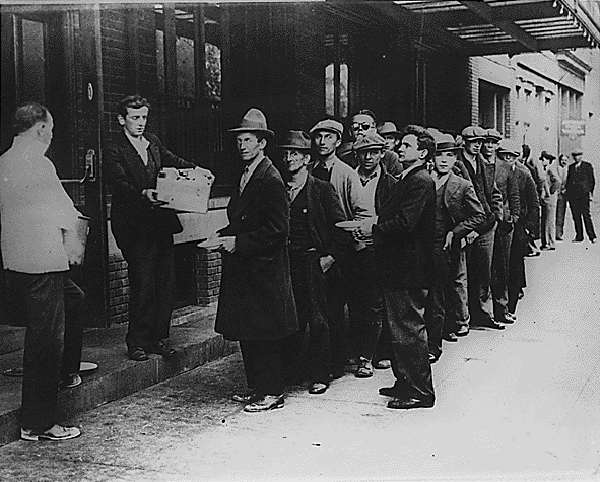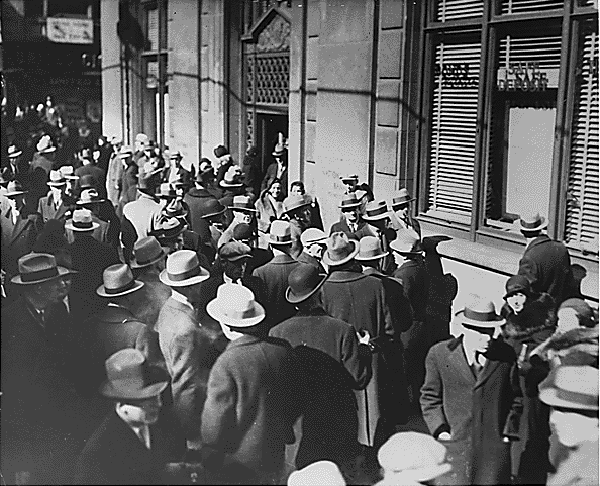The Great Depression - Page 2
The Great Depression started in the U.S. in 1929, quickly spread to every
part of the world. Most Americans lost everything as banks failed.

FOOD LINE FOR UNEMPLOYED - NATIONAL
ARCHIVES

CITIZENS AND CLOSED BANK
- NATIONAL ARCHIVES
Business
Franklin D. Roosevelt, elected in 1932, primarily blamed the excesses of big business for causing an unstable bubble-like economy. Democrats believed that the problem was business had too much power, and the New Deal was intended as a remedy, by empowering labor unions and farmers (which it did) and by raising taxes on corporate profits (which proved a failure). Regulation of the economy was a favorite remedy. Some New Deal regulation (the NRA and AAA)) was declared unconstutional by the U.S. Supreme Court. However the Securities and Exchange Commission, Federal Reserve, Social Security and other laws and regulations won widespread support which continues to this day.
Government deficit spending
Massive increases (by 1930s standards) in taxes, deficit spending, new banking regulation, and so forth, did start turning the U.S. economy around in 1933 but it was a slow and painful process with the U.S. not returning to 1929's GNP for over a decade and still having a unemployment rate of about 15% in 1940--down from 25+% unemployed in 1932 but still high. The unemployment problem was not "solved" until the advent of World War II and the drafting of 11 million men, removing about 20% of the work force. All the deficit spending during World War II did little initially to improve the economy even though nearly everyone who wanted a job could have one. Rationing and wage controls meant a limited supply of consumer goods, as 40% of the economy went to war production. Finally by about 1944 all of this deficit spending and investments in capital goods started showing up in the civilian economy as ten years of depression and four years of war finally ended.
Recession of 1937
The Recession of 1937 was a sharp economic downturn in the United States in 1937-38. It was part of the Great Depression in the United States, and had serious political results.
Background
By 1936, all the main economic indicators had regained the levels of the late 1920s, except for unemployment, which remained high. In 1937, the American economy took an unexpected downturn, lasting through most of 1938. Production declined sharply, as did profits and employment. Unemployment jumped from 14.3% in 1937 to 19.0% in 1938. In two months, unemployment rose from 5 million to over 9 million, reaching almost 12 million in early 1938. Manufacturing output fell off by 40% from the 1937 peak; it was back to 1934 levels. Producers reduced their expenditures on durable goods, and inventories declined, but personal income was only 15% lower than it had been at the peak in 1937. In most sectors hourly earnings continued to rise throughout the recession, which partly compensated for the reduction in the number of hours worked. As unemployment rose, consumers' expenditures declined, leading to further cutbacks in production.
Response
The recession was short, and by 1939 the effects had disappeared.
The Administration's main response to the 1937 recession was a $5 billion spending program in the spring of 1938, an effort to increase mass purchasing power.
Recovery
The recovery phase began in mid-1938, and every month marked an improvement. However, employment did not regain the 1937 level until the war boom began in late 1940. Productivity steadily increased, and output in 1940 was well above the levels of both 1929 and 1937. Personal income in 1940 was almost at 1929 levels in aggregate, but not per capita. The farm population had fallen 15%, but farm output was up 19%, so the remaining farmers were better off than the average farmer in 1929.
Employment in private sector factories recovered to the level of the late 1920s by 1937 but did not grow much bigger until the war came and manufacturing employment leaped from 11 million in 1940 to 18 million in 1943.
| << previous page | next page >> |